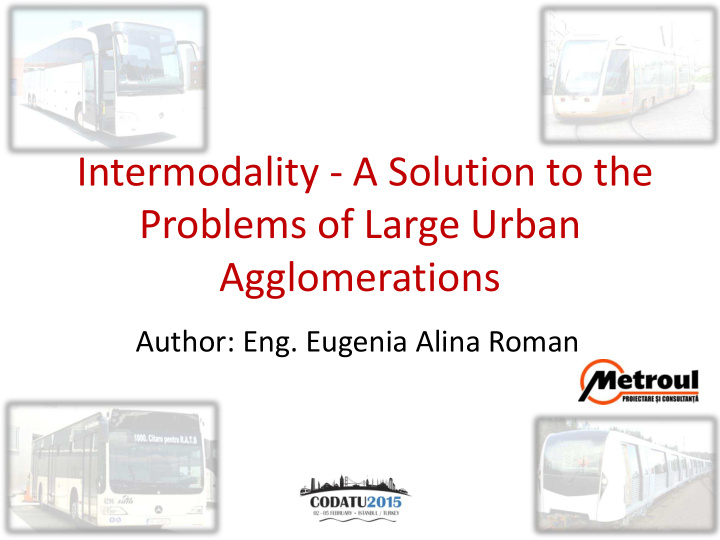



Intermodality - A Solution to the Problems of Large Urban Agglomerations Author: Eng. Eugenia Alina Roman
DN1 A3 DN2 DN7 DN3 A1 Area : 228 square kilometres A2 A major intersection of Romania ’ s DN6 National Road Network : DN4 DN5 7 national roads 3 highways
Problems of large urban agglomerations • Sharp increase of individual mobility • The increasing use of private transport with implications on: o Uncontrolled expansion of Volume – Capacity Ratio in cities; Bucharest City Centre Source: Master Plan de Transport Urban - Bucuresti, Sibiu si Ploiesti o Traffic congestion; o Increased consumption of space; o Road infrastructure damaged; o Polution.
Uncontrolled expansion of cities • long travel distances • high dependence on private transport • reduced traffic safety conditions • increased congestion • dangerous conditions for nonmotorised transport • long walking distances Source: ttp://www.ourpatch.com.au/system/attachments/0003/3949/Megatropolis.jpg
Solutions to the problems of large urban agglomerations - reducing travel need; - encouraging travel on short distances; - cities with high density; - mix of urban functions; - encouraging the use of non-motorized transport; - increasing the attractiveness of public transport.
The concept of intermodality and its sustainability • Definition : Intermodal Passenger Travel: Seamless door-to-door travel using several transport modes • Concept : Combination of transport specific advantages for a safer, cleaner, more comfortable and more efficient transport system • The advantages of intermodal transport: – decreasing space consumption – reduce the traffic congestion – decrease the pollution effects
Intermodality problems in Bucharest • Non provision (or inadequate standard) of the infrastructure for local links; • Poor design, maintenance or operation of intermodal points; • Inefficient procedures for interchange (e.g. delays); • Inadequate provision of local transport services (e.g. no fast public transport from an airport to city centre); • Local transport services exist but do not serve the needs of connecting long distance travellers (e.g. time tables are uncoordinated, nearest bus stop requires a long walk); • Inadequate provision of information; • Unavailability of integrated tickets (covering the local as well as the long distance parts of the journey).
Problems of passenger regional transport in Bucharest city Lack of coordination between local transport and regional transport has led to long paths through city for regional buses Regional buses cross the city and generate additional traffic They don ’ t have predetermined stop points and they stop on street along paths Small capacity buses with 19 seats are used for passenger regional transport Passenger regional transport paths through city
Regional Bus Terminals 32 regional bus terminals more than 10 bus terminals in Bucharest’s inner ring road
Number of regional bus service trips • 300 minibuses are crossing the city centre every day • The biggest minibus traffic flow is on national road DN7 – with 683 minibuses per day Number of service trips <=50 <=100 <=300 <=400 <=500 <=600 <=650 >650
Solution for decreasing minibus traffic inside the city Replacement of the minibuses with large Traffic flows generated by buses( with a minimum transport capacity of minibuses will be reduced by 50 seats) 2.5 times Setting locations for intermodal terminals so the regional buses can no longer enter in the city centre When choosing the future places for intermodal terminals we should consider the locations: • next to city borders; • near or in an local transport network node providing passengers easy access to local and regional transport networks; • near railway stations or passenger station buildings; • near the commercial and administrative centre of the village; • regional buses paths should not cross roads carrying heavy traffic (with large traffic flows).
Future regional bus terminals Proposal for future intermodal terminals locations (regarding only the conection between regional and local transport) situated on main national roads 650 meters – 5 kilometers far from city borders
Expected results Eliminate the regional bus traffic from city centre Reduced mobility/ need to travel Increased accesibility of public transport Increased atractivity of public transport Decreased road traffic Increased road safety Changing in user behaviors Changings in urban form leding to a compact city
Recommend
More recommend